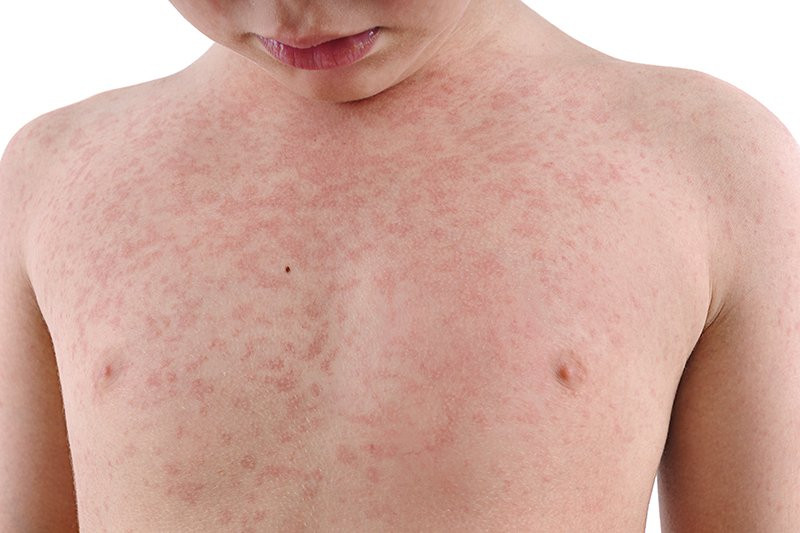Definisi
Campak (nama lain: measles, morbili, rubeola) adalah infeksi yang disebabkan oleh virus. Infeksi ini biasanya dimulai dari sistem pernapasan, yang kemudian menyebar ke seluruh tubuh. Infeksi ini dapat dicegah dengan imunisasi campak atau MR/MMR. Meskipun imunisasi sudah tersedia secara luas, penyakit ini memiliki angka kematian sekitar 200.000 anak per tahunnya, dan terjadi terutama pada anak yang tidak diimunisasi campak.
Penyebab
Campak disebabkan oleh virus dari keluarga Paramyxovirus. Virus merupakan kuman berukuran sangat kecil yang hanya dapat hidup menumpang pada makhluk hidup lainnya. Ketika seseorang mengalami infeksi virus, virus akan masuk ke sel inangnya dan menggunakan bagian sel untuk hidup dan membelah diri.
Virus campak sangat mudah menular lewat saluran pernapasan. Penularan tertinggi terjadi sekitar empat hari sebelum dan empat hari sesudah ruam muncul. Jika seseorang yang sedang sakit campak batuk, bersin, atau berbicara, droplet atau titik-titik air akan menyebar di udara dan dihirup orang lain. Droplet dapat bertahan di udara hingga 1 jam. Droplet ini juga dapat hinggap pada permukaan benda dan bertahan selama beberapa jam. Anda dapat tertular campak ketika memasukkan tangan ke mulut atau hidung dan mengucek mata setelah menyentuh permukaan benda yang terinfeksi.
Setelah masuk ke saluran pernapasan, virus menyebar ke seluruh tubuh lewat peredaran darah.
Faktor Risiko
Faktor risiko campak adalah sebagai berikut:
- Tidak imunisasi campak. Jika Anda belum diimunisasi campak, risiko Anda untuk mengalami campak jauh lebih tinggi
- Bepergian keluar negeri. Jika Anda pergi ke negara dengan kasus campak yang tinggi, Anda memiliki risiko tinggi untuk tertular campak
- Defisiensi vitamin A. Jika Anda kekurangan vitamin A dalam diet sehari-hari, Anda dapat mengalami gejala campak yang lebih parah, bahkan mengalami komplikasi dari campak
Gejala
Gejala campak pada umumnya muncul sekitar 10-12 hari setelah terpapar virus. Gejala ini dapat berupa:
- Batuk
- Demam
- Pilek
- Mata merah
- Radang tenggorokan
- Bercak putih di dalam mulut (bercak Koplik)
Gejala-gejala di atas pada umumnya muncul sebelum ruam muncul pada kulit.
Ruam kulit di seluruh tubuh merupakan tanda klasik campak. Ruam ini dapat terjadi hingga 7 hari dan pada umumnya terjadi dalam 14 hari setelah terpapar virus. Biasanya, ruam dimulai dari belakang telinga, lalu menyebar ke seluruh tubuh.
Infeksi ini terjadi dalam 2-3 minggu, dengan tahapan sebagai berikut:
- Infeksi dan inkubasi. Pada 10-14 hari pertama setelah terpapar virus, virus akan menyebar ke seluruh tubuh tanpa ada gejala
- Tanda dan gejala tidak khas. Campak pada umumnya dimulai dengan demam ringan atau sedang, disertai oleh batuk, pilek, mata merah, dan nyeri tenggorokan. Tanda dan gejala ini biasanya bertahan hingga 2-3 hari
- Penyakit akut dan ruam. Ruam pada campak merupakan ruam kemerahan berukuran kecil, yang sedikit meninggi dibandingkan kulit normal. Biasanya, ruam ini muncul dari belakang telinga, wajah, kemudian ke lengan, dada, punggung, dan tungkai. Pada saat ini, penderita juga biasanya mengalami demam tinggi
- Pemulihan. Ruam dapat bertahan hingga 7 hari. Urutan ruam menghilang sama dengan urutan munculnya, mulai dari wajah, lengan, dada, punggung, terakhir tungkai. Batuk, perubahan warna ruam menjadi lebih gelap, serta pengelupasan kulit dapat terjadi hingga 10 hari kemudian
Diagnosis
Dokter dapat mendiagnosis campak dengan mengamati ruam serta mencari gejala lainnya yang menjadi ciri penyakit campak, seperti bercak putih di dalam mulut, demam, batuk, dan nyeri tenggorokan. Dokter juga dapat melakukan pemeriksaan laboratorium untuk mencari adanya virus campak di dalam tubuh Anda atau anak Anda.
Tata Laksana
Tidak ada pengobatan dan terapi spesifik untuk campak. Pemberian antibiotik tidak mampu menyembuhkan penyakit ini, karena penyakit ini disebabkan oleh virus, sementara antibiotik hanya efektif terhadap bakteri. Virus dan gejala-gejala campak pada umumnya hilang setelah 2-3 minggu.
Jika Anda atau anak Anda baru saja terpapar virus campak, Anda dapat melakukan beberapa hal untuk mencegah campak atau menurunkan keparahannya, misalnya:
- Vaksin campak dalam 72 jam setelah terpapar virus
- Pemberian imunoglobulin (protein kekebalan tubuh) dalam 6 hari setelah terpapar virus
Dokter juga dapat memberikan beberapa saran untuk Anda dan anak Anda dalam menata laksana campak, seperti:
- Pemberian parasetamol atau ibuprofen untuk menurunkan demam
- Istirahat untuk meningkatkan kekebalan tubuh
- Konsumsi air dalam jumlah cukup atau lebih banyak daripada biasanya
- Pemberian obat batuk untuk mengurangi batuk dan radang tenggorokan
- Suplemen vitamin A
Komplikasi
Komplikasi campak dapat berupa:
- Diare dan muntah. Diare dan muntah dapat menyebabkan kehilangan cairan dalam jumlah banyak (dehidrasi)
- Infeksi telinga. Salah satu komplikasi tersering campak adalah infeksi telinga akibat bakteri
- Bronkitis, laringitis, dan croup. Campak dapat menyebabkan iritasi dan pembengkakan (inflamasi) saluran napas, yang disebut sebagai croup. Iritasi dan pembengkakan ini juga dapat terjadi pada cabang tenggorok menuju paru kiri dan kanan (bronkus), yang disebut sebagai bronkitis. Campak juga dapat menyebabkan iritasi dan pembengkakan pada pita suara, yang disebut sebagai laringitis
- Pneumonia. Campak sering menyebabkan infeksi paru (pneumonia). Orang dengan kekebalan tubuh yang lemah dapat mengalami pneumonia yang cukup parah hingga menyebabkan kematian
- Ensefalitis. Sekitar 1 dari 1.000 orang yang mengalami campak dapat mengalami ensefalitis atau iritasi dan pembengkakan pada otak. Kondisi ini dapat berbahaya pada orang-orang kekebalan tubuhnya rendah. Ensefalitis dapat terjadi tepat setelah ruam muncul atau beberapa bulan kemudian. Tidak hanya itu, penyakit ini dapat menyebabkan kerusakan otak permanen
- Masalah kehamilan. Jika Anda sedang hamil, Anda perlu menghindari campak karena penyakit ini dapat menyebabkan kelahiran kurang bulan, berat badan lahir rendah, dan kematian janin
Pencegahan
Beberapa cara dapat dilakukan untuk mencegah penularan campak, seperti:
- Rutin mencuci tangan dengan air mengalir dan sabun
- Menggunakan tisu ketika bersin atau batuk
- Membuang tisu bekas ke dalam tempat sampah
- Tidak berbagi alat makan, gelas, handuk, pakaian, dan seprai dengan penderita
- Penderita sebaiknya tidak masuk kerja atau sekolah hingga 4 hari setelah ruam hilang
- Menjauhkan orang-orang yang belum diimunisasi campak (biasanya anak-anak di bawah usia 9 bulan) dari penderita
- Imunisasi campak. Di Indonesia, imunisasi campak dapat diberikan dalam dua bentuk: MR (measles dan rubella) dan MMR (measles, mumps, dan rubella). Imunisasi MR dapat dimulai dari usia 9 bulan dan booster pada usia 18 bulan. Sementara itu, imunisasi MMR dapat dimulai dari usia 12 bulan dan booster pada usia 18 bulan. Selanjutnya, imunisasi dapat diulang pada usia 7 tahun (mengikuti Bulan Imunisasi Sekolah pada kelas 1 SD). Perlu diingat bahwa imunisasi MMR tidak menyebabkan autisme.
Kapan harus ke dokter?
Anda dapat berkunjung ke dokter jika Anda atau anak Anda baru saja terpapar oleh virus campak. Anda juga dapat berkonsultasi apabila anak Anda mengalami ruam kemerahan di seluruh tubuh yang mirip dengan campak. Anda sebaiknya melengkapi status imunisasi Anda dan anak Anda sebelum memulai sekolah, kuliah, bekerja, menikah, memiliki anak, atau bepergian keluar negeri.
Mau tahu informasi seputar penyakit lainnya? Cek di sini, ya!
- dr Anita Larasati Priyono
Higuera, V., & Gill, K. (2019). Measles: Symptoms, Diagnosis, and Treatments. Retrieved 11 May 2022, from https://www.healthline.com/health/measles
Measles. (2022). Retrieved 11 May 2022, from https://www.nhs.uk/conditions/measles/
Measles - Symptoms and causes. (2022). Retrieved 11 May 2022, from https://www.mayoclinic.org/diseases-conditions/measles/symptoms-causes/syc-20374857










